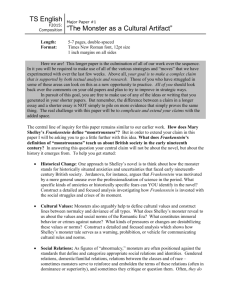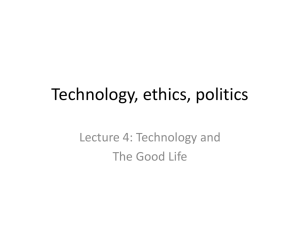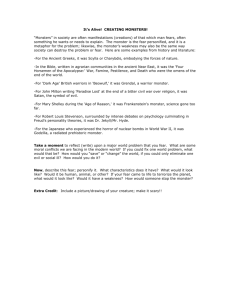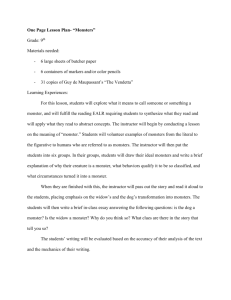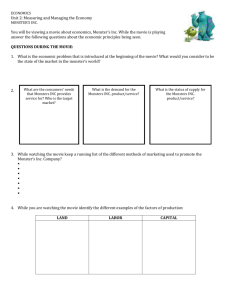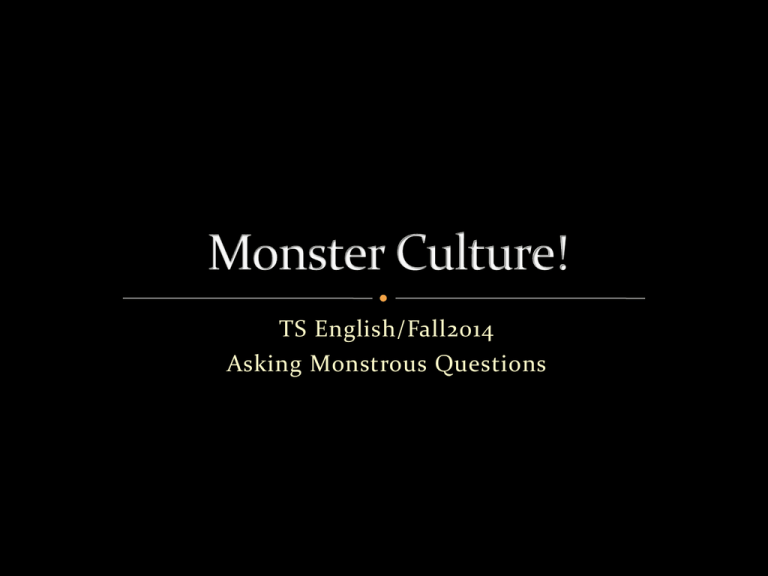
TS English/Fall2014
Asking Monstrous Questions
Academic writing is built upon a “line” of academic inquiry.
It is motivated by a number of different types of questions
about how the world (physical, metaphysical, social)
works.
Inquiry is, first and foremost, a “habit of mind”:
Openness to Possibility: Opening questions are followed by
more informed questions as research reveals new details and
as new facts come to light. The investigation can often take
unexpected turns and angles, and may require you to think
about things you didn’t expect to have to deal with.
Skepticism: All previously positions can be reevaluated when
new information suggests that it is necessary. Nothing is
more important than making sure that your own position is
supportable and properly nuanced.
To start, inquiry begins by making observations. In
this case, the inquiry-based “habits of mind”
Openness: Be willing to look at the world and ask
“why?” Recognize that there are many facets to this
world and, thus, we need multiple ways of answering
this question (physical, social/political, biological) .
Recognize that things have multiple angles and can be
understood productively from multiple perspectives.
Think creatively about both questions and hypotheses.
Skepticism: Be wary of “common-sense” or untested
truth. Be willing to question held belief and
assumptions, especially your own! Be open to criticism
of ideas or concepts you consider reliable.
Monster stories have a long history
The “modern” period (17th-18th C) introduces a new
type of secular monster story, many of which have
been assimilated into the category of “Classic
Literature”
Shelley’s Frankenstein (1818)
Stevenson’s, The Strange Case of Dr. Jekyll and Mr. Hyde
(1886)
Wells’, The Invisible Man (1897)
Stokers’ Dracula (1897)
These narratives have assumed a new type of
popularity through film, which has taken up monster
stories since its earliest stages.
Frankenstein (1910)
Nosferatu (1922)
King Kong (1933)
Of course, beyond these early examples there are too
many monster movies to mention or summarize!
Monsters and monster narratives also appear in a
whole variety of other genres and forms including;
Video Games
Comic Books
Political Cartoons
Children’s Stories
Cereal Boxes
Other?
Monster stories are a whole genre – a popular TYPE of
story that gets told over and over…
Other examples: detective stories, romance narratives,
spy dramas, ghost stories (are they monsters?), etc
The genre is both highly conventional and diverse
Conventional: certain aspects of the genre repeat and
maintain common themes
Diverse: we are always inventing new monsters to
frighten ourselves with
This will be an essential question for us as we
investigate Frankenstein and other monster narratives
over the course of this quarter.
Why are these the stories we like to tell ourselves? What
desires do they fulfill?
Considering their diversity, by what logic are they
categorized? What makes something a “monster”?
Why do horror stories appear so regularly? Do they have
some kind of function? How and why do they change?
It will be essential for us to not only come up with
some answers to these questions, but to answer them
in an academic manner!
Common knowledge and attitudes would tell us that
fictional narratives about monsters – horror films, monster
stories, etc. – are simply a cheap form of popular
entertainment. Most, unlike more “serious” literature, do
not count as culturally significant.
They exist purely to shock us, frighten us, and otherwise
take us away from our real lives.
They are escapism and distraction. An adrenaline rush.
IS THIS REALLY IT?
• From a comic
called The Silver
Streak (1940)
Opened in 1954 –
(Cold War)
1960 (Cold War)
• One of the many adaptations of the Dracula story for film and popular
culture
Opened in 2008.
In our informal inquiry on Wed, we constructed a
series of analytic observations that seemed to
challenge the “common-sense” notion that monster
fictions are simply “diversion” or “entertainment.”
We noted the importance of:
Social prejudice; political difference; global, ethnic
conflict; the concept of “social fears/anxiety”
Social norms/values; gender/family
The idea of “boundaries”; prohibitions; illegitimate or
legitimate behaviors; violence
Remade in 2010
Opening one month
before Cloverfield
Released in 2001
How has your definition of a “monster” changed
through this analysis?
What are the most important insights, ideas, or issues
that you have noticed?
How has your perspective/definition changed over the
course of this investigation?
What new questions can we ask?
What still needs further inquiry?
What else should we look at to make our definition
more comprehensive?

